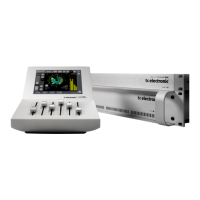47
MD-4
delayinfluenced“wet”partofthesignal.Insidethe
algorithm,beforethelimiter,the“dry”and“wet”signalsare
summed.
When Trim and Band gains are all 0.0 dB, gain through
MD-4 in parallel mode is unity, provided the signal is below
the Threshold of compression.
Usershavesuggestedanalternativecalculationof
gain for Parallel Mode, namely to provide unity gain
with Trim at 0.0 dB, and all Band Gains at Off. If
you too prefer parallel compression to be purely
additive,walkthisway:SetTrimat+6.0dB,and
turn all Band Gains Off. This will cause gain to be
unity. Now, use the Band Gains to add gain. In this
case,+6dBwillbereachedwhentheBandGains
are at 0.0 dB. If the current way of setting gain in
Parallel Mode is changed in a future software
update, information will be provided to translate
presetsbasedonthe3.50gainstructure.
DXP mode
DXP Mode is a new five-band detail enhancer with an
integratedBrickwall2LimiteratitsOutput.DXPMode
was designed as an alternative to traditional dynamics
processing - to lift up low level subtleties rather than
boosting and limiting elements that are already loud.
As seen on the level diagram, an inactive processing
area is available above the Reference Level but below
the Threshold of Limiting, so material neither too soft, nor
too loud can be left unaltered. Consequently, DXP mode
offers a flexible tool for hi-res processing, which may be
used with good results even on sensitive material such
aclassicalorothertypesofacousticmusic.Usedon
spokenwordorsinging,DXPmodecanimprovespeech
intelligibility, and add extra character and expression.
Individual frequency bands may have different detail
enhancement applied, and DXP can be combined with MS
discrimination, for instance to lift up low level de-correlated
components(wide=S)suchasambience,ortotreatfully
correlatedcomponents(center=M)inacertainway.Preset
examplescanbefoundinEngineFactoryBank10,
decade5.
DXPprocessingdoesn’taddanythingtothesignalthat
isn’ttherealready.Itmerelymagnifiesthedetailsor
spectral components which previously may have been
masked.LikeNormalandParallelmode,resolutionofDXP
mode is 48 bit fixed point to maintain a processing margin
over the source material.
Fromauserspointofview,thismodeintroducesanew
parameter on each band, Steer, instead of Threshold.
Steer determines the slope and boost of that particular
band as shown in the level diagram. Bands hit unity gain (0
dB gain) at the Reference Level, so low level boosting only
takesplacebelowthatlevel,andisatthemaxbeloweach
band’sThreshold.Note:Unitygaindependsonthecrest
factor of the input signal. Reference Level should be set
approximately 2 dB lower if a unity gain point is determined
with a tone. Alternatively, Band Gains may be trimmed
down by the same amount.
If low level Steer gain brings up too much noise, a Defeat
function is available to revert to unity gain a certain number
of dB below the DXP threshold.
Example:
With the following settings:
- LimitThresholdsetat-3dBFS,
- ReferenceLevelat-12dBFS,
- DXP Threshold at -14 dB and
- Defeat at -20 dB,
therewillbeunitygainbetween-12dBFSand-3dBFS,
andfulllowlevelgainbetween-26and-46dBFS.The
slopewithwhichMD4revertstounitygainbelow-46dBFS
is determined by the Defeat Ratio.
Look Ahead Delay
Range:0to15ms
LookAheadDelayintroducesanaudiodelaytoallow
processingtotakeplaceatpreciselytherighttime.It
influencesthe5Bandsectionregardlessofitsmodeof
operation (Normal, Parallel and DXP plus gain Defeat). The
Brickwalllimiterattheoutputisindependentofthissetting,
andusesaitsownlookahead.
Eachofthe5bandshasitsownlookaheaddelay,which
canneverbelongerthantheLookAheadDelayparameter.
However,lookaheadintheindividualbandsmaybe
shorterthanthattopreventattacktooperate“aheadof
time”.Forexample,ifLookAheadDelayissetat10.0ms,
andAttackintheHiBandat3.0ms,thatparticularband
willonlyusealittlemorethan3msofthelookaheaddelay
it has at its disposal. The actual audio delay is of course
alwaysthesameinall5bands.
Tip:IfAttacktimesofdoubletheLookAheadDelayor
lessareusedinthe5Bandsection,thissettingmayhave
abiginfluenceonMD4’speakhandlingandtherefore
sound.However,iflongerAttacktimeshavebeenchosen,
LookAheadDelaywillnotmakemuchdifferencetothe
processing - besides from introducing a delay in the signal

